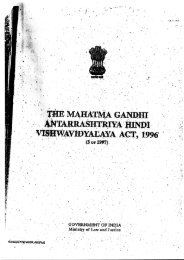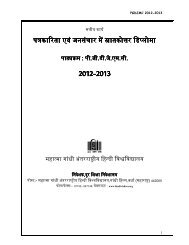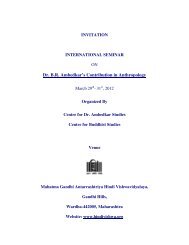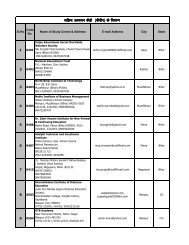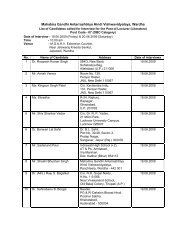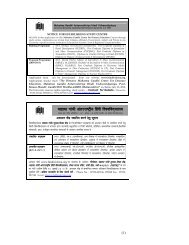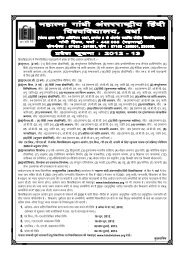A Journal of Mahatma Gandhi Antarrashtriya Hindi Vishwavidyalaya
A Journal of Mahatma Gandhi Antarrashtriya Hindi Vishwavidyalaya
A Journal of Mahatma Gandhi Antarrashtriya Hindi Vishwavidyalaya
Create successful ePaper yourself
Turn your PDF publications into a flip-book with our unique Google optimized e-Paper software.
Seeing their unbending resolve, <strong>Gandhi</strong>ji<br />
had to comply and allow them to join.<br />
Dandi March and its culmination–the Salt<br />
Satyagrah – proved how women could<br />
in fact work more and harder than men.<br />
Many such instances show the influence<br />
that these leaders harbored coming from<br />
‘gender’ based prejudices begot by the<br />
patriarchal order. Many factors ensured<br />
that Indian women’s struggle for<br />
emancipation was easier when compared<br />
to those <strong>of</strong> Europe. European women had<br />
to struggle long and hard to earn their<br />
political rights and suffrage. In 1928,<br />
Sarojini Naidu put forth the proposal to<br />
allow women their right to vote councils<br />
in a Congress meeting held in Mumbai<br />
(then Bombay). Madan Mohan Malviya<br />
took strong exception to that. The proposal<br />
was passed despite his opposition. It can<br />
be said that the educated middle class<br />
participating in the Freedom Movement<br />
used to support women in their path to<br />
empowerment, even if for a few steps.<br />
In India, feminists and supporters <strong>of</strong><br />
women’s liberation have done perilous<br />
struggle not just for their own cause.<br />
Feminists have led and have been part<br />
<strong>of</strong> several social movements, like Bodhgaya<br />
Mukti Movement, Chipko movement, and<br />
the struggle in Andhra Pradesh against<br />
alcohol which also destabilized the then<br />
government. Women have also been fairly<br />
successful in these attempts. In this respect,<br />
it has been the unique accomplishment<br />
<strong>of</strong> women’s struggle in India, besides being<br />
a marker <strong>of</strong> the expanse and depth <strong>of</strong><br />
the movement.<br />
A century ago, a Utopia <strong>of</strong> women’s<br />
emancipation was authored by Rukaiya<br />
Sakhavat Hussain in her work titled ‘Sultana<br />
ka Sapna’. In it, men did all the household<br />
work and women looked after the public<br />
matters. Although the idea for this Utopia<br />
was not seated in hostility, it did reverse<br />
the operation <strong>of</strong> society to realize itself.<br />
The present discourse <strong>of</strong> women’s<br />
emancipation is far ahead <strong>of</strong> that thinking.<br />
It doesn’t merely invert the binary; instead<br />
it seeks to ensure collaboration,<br />
independence and equanimity.<br />
It is <strong>of</strong> note that Utopia and Reality<br />
are not mutually exclusive. Both are in<br />
a dialectical relationship. Understanding<br />
and unraveling layers <strong>of</strong> reality lead to<br />
Utopia taking shape. The concept <strong>of</strong> Utopia,<br />
on the other hand, allows us to perceive<br />
our reality better, and aids us in grappling<br />
with and resolving its conundrums. The<br />
Utopia <strong>of</strong> women’s liberation can, therefore,<br />
not be carved without understanding the<br />
many aspects <strong>of</strong> reality. Patriarchy has<br />
a multi-layered relationship with the<br />
structure <strong>of</strong> society. Therefore, it is only<br />
by keeping these aspects in cognizance<br />
that the roadmap to this Utopia can be<br />
formulated. Given the complex web <strong>of</strong><br />
Patriarchy, it is impossible to emancipate<br />
women completely without changing the<br />
entire social structure. One day, this Utopia<br />
142 :: January-March 2012




